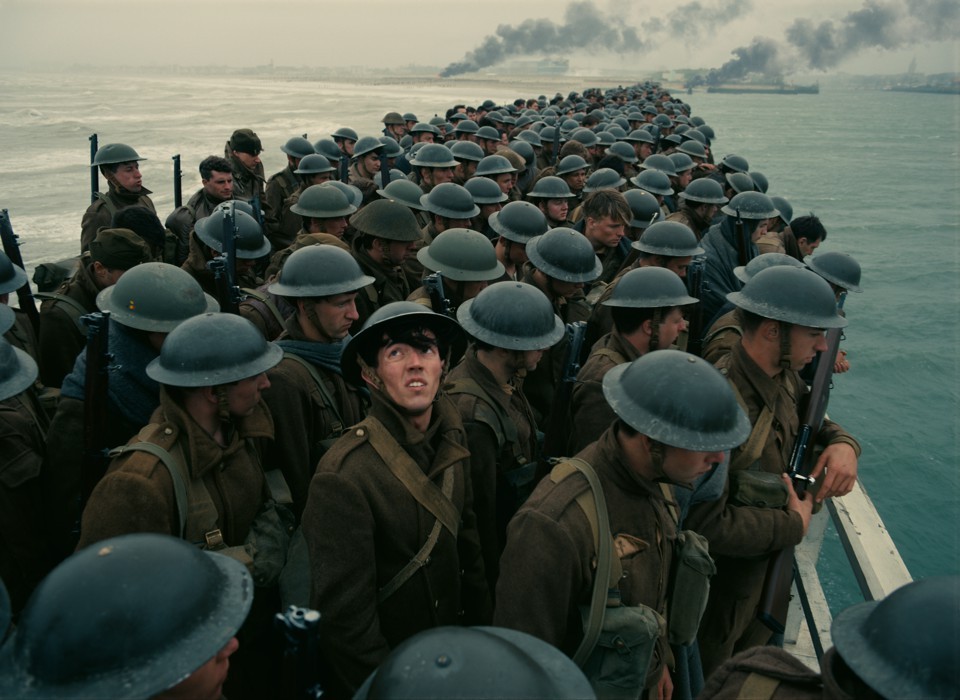AUGUST 15, 2017
I have a problem with Christopher Nolan.
The director of such acclaimed films as “Inception” and “The Dark Knight” trilogy has reviewers and acolytes falling all over themselves raving about his work, but for some reason, I’ve always found his films to be frigidly cold. There’s nothing wrong with cold per se (Ingmar Bergman’s films were hardly warm and fuzzy) but to go that audience-alienating route, there should be some kind of higher aesthetic reason for it. And I didn’t get that from Nolan, at least in his later films.
Early in his career, Nolan made some small, terrific movies, especially “Memento” (2001), a twisty psychological thriller in which a husband (Guy Pearce) tries to solve his wife’s murder, but it is difficult for him to piece together clues because he suffers from a condition that produces short-term amnesia. The story of “Memento” is told chronologically in black-and-white clips and in reverse order in color sequences. It sounds gimmicky, I know, but it works like a charm, largely because the split focus mirrors the man’s state of mind.
But Nolan’s interest in mind puzzle games, for me at least, began to fade in effectiveness as his canvas became bigger. The gloomy “Batman Begins” (2005) was an interesting counter-take from the camp of the TV series, and the much beloved “The Dark Knight” (2008) at least had that Oscar-winning performance from Heath Ledger as The Joker to distract from all the lugubriousness. But “The Dark Knight Rises” (2012) was a total swing-and-a-miss for me, with Tom Hardy’s normal expressiveness hidden behind a mask for 2 hours and 45 minutes. Oy.
So I approached Nolan’s latest film “Dunkirk” with some trepidation, but I needn’t have. It’s actually very good, despite Nolan’s occasional bombast. “Dunkirk” chronicles the massive evacuation of Allied troops from a French beach in 1940 as the Nazis begin to close in on them.
Nolan loves to play with time in his films. I often find time shifts to be pretentious, but somehow it works here. Here he divides his storytelling into three different timelines. The first is called “The Mole” and it takes place over the course of one week. The second is entitled “The Sea” which takes place over the course of one day and the third is “The Air,” which spans the course of one hour. Nolan, however, cuts them together as if they are all happening concurrently, which happens to be a great idea.
Let’s start with The Mole. Our guide into this world is Tommy (Fionn Whitehead), a young British private, who barely escapes German gunfire to make it to the beach where hundreds of troops are waiting for troop ships that will bring them back to England. Only they don’t. When a rescue ship does come in, Tommy enlists French soldier Gibson (Aneurin Barnard) carry a wounded soldier on a stretcher and barrel to the head of the line of waiting soldiers. The wounded soldier is accepted onto the ship, but not Tommy and Gibson, who must hide onto the pier in an area called The Mole for another ship, from which they can escape. Once they get on board that ship, their week upon that ship is another that either one anticipated.
The most audience-involving section is The Sea. The Royal Navy is commandeering private boats to head to Dunkirk, but Mr. Dunkirk (Oscar-winner Mark Rylance) decides to pilot his boat himself along with his son Peter (Tom Glynn-Carney) and his teenage crew member George (Barry Keoghan) who hops on board at the last moment. They head to Dunkirk, where they hope to rescue some of the waiting soldiers.
The Air is less involving than the other sections, largely because the actors playing the pilots are masked throughout. The Air sequences are very well shot, but it wasn’t until one of the film’s final shots that I realized that one of the pilots was Tom Hardy. (Masked again, just like in “The Dark Knight Rises.”)
One of the things I liked about “Dunkirk” was that it was all business — the film efficiently did what it set out to do in a compact 107 minutes, unlike the 167-minute sprawl that was “The Dark Knight Rises,” even though “Dunkirk” manages to do story-wise nearly as much as that bloated Batman movie.
Just as an aside, it’s interesting that you never hear the word “German” or “Nazi” in the film, or even see them until near the end of the film, where they appear out-of-focus. That decision keeps “Dunkirk” from being an “Us vs. Them” movie, instead being just about “Us.”
“Dunkirk” provides a very valuable lesson to me — don’t dismiss a filmmaker just because you haven’t liked very many of his films in the past. They may surprise you, as Nolan did to me in “Dunkirk.”
GRADE: B+












